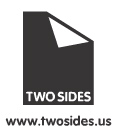Do Americans Still Prefer Print and Paper Communications?


Most of those surveyed also believe that paper records are more sustainable than electronic record storage (68 percent) and that paper is more pleasant to handle and touch than other media (67 percent). But survey results also show that many Americans still have misconceptions about the environmental impacts of print and paper.
The Two Sides survey indicates a majority of respondents are concerned about the effect of print and paper production on forests and believe that there is a connection between the loss of tropical rainforests and the manufacture of paper.
The survey also found that more than half respondents believe that electronic communications are a more environmentally friendly way to read books, magazines, and mail. “That's another myth that has been perpetuated by financial institutions, utilities, and other organizations that are trying to save money by encouraging consumers to go green by going paperless,” Phil Riebel, Two Side's President, says. “The fact is that both electronic and paper-based communications have an environmental footprint, and making both smaller is the right environmental choice.”
Doc agrees with that last point, but remains skeptical of some of this report's findings – I'd like to see the full survey and understand the methodology a little better. You can find out more about the sponsoring organization here.